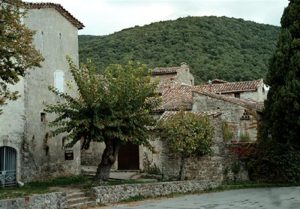A religious life centred around the Temple
The reformed first met in private homes or, weather allowing, beneath the chestnut trees.
From 1562 to 1569, a first temple was built : a rectangular building, built on the square between the castle and the three-gabled house. The front side has a large doorway. Two side doorways open on the Esplanade Place and the Combe d’Aze Street.
It had a seating capacity of 800 to 1,000 worshippers. No steeple had been built prior to 1669, and use was made of the bell of the Clock Tower that had belonged to the ancient abbey.
Inside the temple, a vast tribune was upheld by columns. Other tribunes as well as a balcony were added later.
At the end of the 16th century, only 17 Roman Catholic families remained in Saint-Jean-du-Gard. The Catholic church building was demolished. The temple became the centre of the town’s religious and political life. Several synods were held there.
Before the Revocation, in February 1685, the temple was destroyed. The stones were used for the building of the Catholic church in 1686.
Saint-Jean-du-Gard was to acquire a new temple only in 1822.







